If you've been hesitating to work with ponte di roma fabric, you're missing out on one of the most versatile materials in modern sewing. This stable double-knit offers the perfect blend of structure and comfort, making it ideal for everything from professional wear to casual basics. While ponte knit presents unique challenges for sewists, mastering a few essential techniques will transform your approach to working with this sought-after fabric. Fortunately, ponte is easy to sew once you understand the right tools and methods. Let's explore the tools and methods you'll need for success.
Key Takeaways
- Use a ballpoint or stretch needle size 80/12 with polyester thread to prevent skipped stitches and fabric damage.
- Set your machine to narrow zigzag stitch at 2.5-3.0mm length with slightly looser tension than normal.
- Pre-wash fabric and align pattern pieces with grainline parallel to selvage for proper stretch and fit.
- Reduce presser foot pressure to medium-light and allow fabric to feed naturally without pulling while sewing.
- Reinforce waistbands and necklines with clear elastic, and use twin needles for professional-looking hems.
Essential Tools for Sewing Ponte Knit Fabric
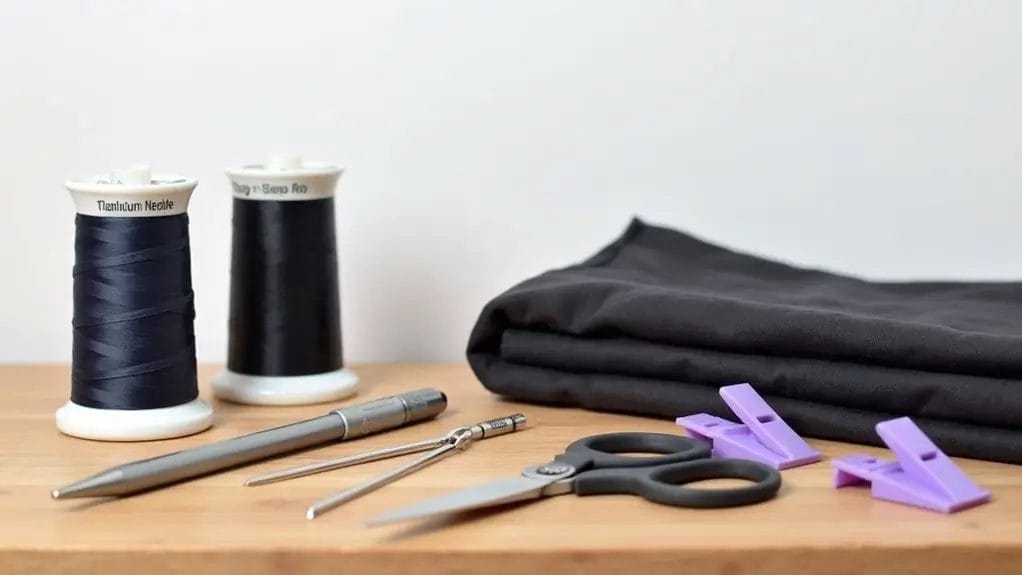
You'll need to set your sewing machine to a narrow zigzag stitch with a length of 2.5-3.0mm and adjust the tension slightly looser than normal for ideal results with Ponte knit fabric.
Select a size 80/12 ballpoint or stretch needle to prevent fabric damage, and pair it with good quality polyester thread that can stretch with the knit.
For best results, test your settings on a fabric scrap before starting your project, making minor adjustments to achieve smooth, even stitches without puckering or skipped stitches.
Recommended Sewing Machine Settings
When sewing with Ponte knit fabric, proper machine settings are essential for achieving professional results. Set your sewing machine to a medium stitch length of 2.5-3.0mm and select a stretch stitch or narrow zigzag.
Use a size 80/12 stretch or ballpoint needle to prevent skipped stitches and fabric damage.
Adjust your presser foot pressure to medium-light to avoid stretching the ponte while sewing. Thread tension should be slightly looser than normal - test on scraps first.
For quality results, use polyester thread that can accommodate the fabric's natural stretch. These settings will guarantee smooth, professional-looking seams.
Best Needles and Threads
Three essential tools are critical for successfully sewing ponte knit fabric: stretch needles, ballpoint needles, and high-quality polyester thread.
When sewing with ponte, you'll need size 80/12 stretch needles for fabrics containing elastane, while ballpoint needles work best with standard double knit varieties.
Visit your local fabric store to find these specialized needles - they'll prevent skipped stitches and fabric damage.
For thread recommendations, choose all-purpose polyester thread that matches your ponte fabric's stretch capacity.
Cotton thread will break under tension, so avoid it. Select thread weight between 40-60 for ideal seam strength and professional results.
Preparing to Sew with Ponte Knit Fabric
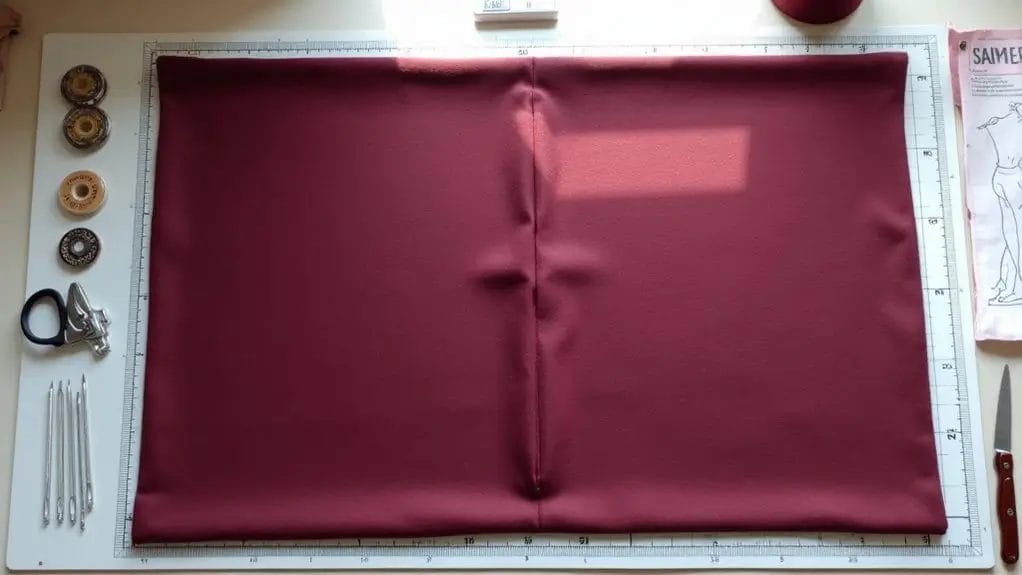
Before cutting your Ponte knit fabric, you'll need to pre-wash and dry it according to the care instructions to prevent future shrinkage in your finished garment.
Place your pattern pieces on the fabric with the grainline parallel to the selvage, ensuring the stretch runs in the direction required by your pattern.
When cutting Ponte knit, use sharp scissors or a rotary cutter on a smooth surface to prevent distortion and maintain the fabric's stable structure.
Pre-Washing and Shrinkage Considerations
The most critical step in preparing ponte knit fabric is pre-washing it using the same temperature and settings you'll use for the finished garment. This prevents unexpected shrinkage after you've completed your project, especially since ponte knit can contain varying amounts of polyester and other fibers that react differently to heat.
- Wash your ponte knit fabric in warm water (30°C/86°F) to remove sizing and test for color bleeding.
- Dry according to fiber content - tumble dry for cotton blends, lay flat for wool blends.
- Press the fabric on medium heat while slightly damp to remove wrinkles and establish grain.
Always check the fabric's care label for specific washing instructions before proceeding with pre-treatment.
Cutting Techniques for Ponte Knit
Proper cutting techniques substantially impact your success when working with ponte knit fabric. Since ponte roma is a stable double knit fabric, you'll find it's easier to cut than other knits.
First, wash and dry your fabric to prevent future shrinkage. Lay your fabric flat on a cutting surface, ensuring there's no stretching or distortion. Use sharp scissors or a rotary cutter for clean edges, and don't let the fabric hang off the table while cutting.
Follow pattern grainlines carefully, and consider using pattern weights instead of pins to keep the fabric in place during cutting.
Sewing Techniques for Ponte Knit
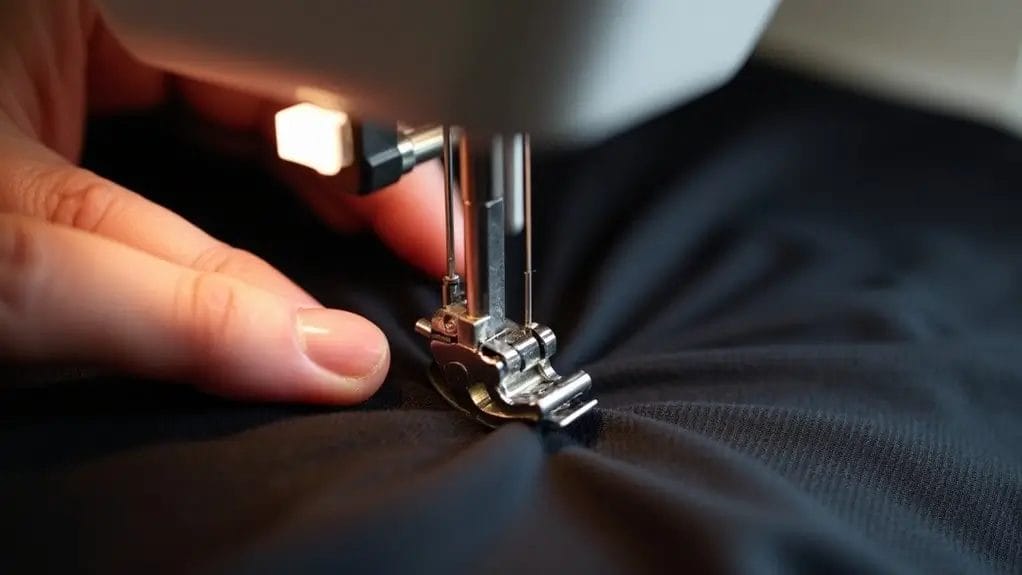
When sewing with Ponte knit fabric, you'll need to select appropriate stitches that maintain the fabric's stretch properties, such as a narrow zigzag or specialized stretch stitch.
You can adjust your machine's tension and stitch length to accommodate the fabric's weight and elasticity, typically using a slightly longer stitch length of 2.5-3mm.
To prevent seams from popping during wear, make certain you're allowing the fabric to feed naturally without pulling or stretching as you sew.
Stitch Types to Use
Selecting suitable stitch types makes a significant difference when working with ponte knit fabric. When you sew ponte roma, you'll need to make sure your machine settings accommodate the fabric's stretch properties while maintaining seam durability.
- Use a narrow zigzag stitch (width: 0.5-1.0mm, length: 2.5-3.0mm) for seams that require flexibility.
- Apply a lightning stitch or stretch stitch for straight seams that need maximum elasticity.
- Set your serger to a 4-thread overlock stitch with balanced tension for professional edge finishing.
Test your selected stitch patterns on fabric scraps before starting your main project to achieve the best results.
Handling Stretch and Recovery
Successful ponte knit garment construction relies on mastering stretch control during the sewing process.
When handling ponte, you'll need to manage the fabric's natural stretch and recovery properties to prevent distortion. Let the fabric feed naturally through your machine without pulling or stretching.
Support the fabric's weight as you sew to prevent the knit from stretching under its own weight.
Test your ponte's recovery by stretching a sample - if it doesn't bounce back quickly, use stabilizing techniques like stay tape at stress points.
Always check your seams after sewing to guarantee they haven't stretched out of shape.
Finishing Touches
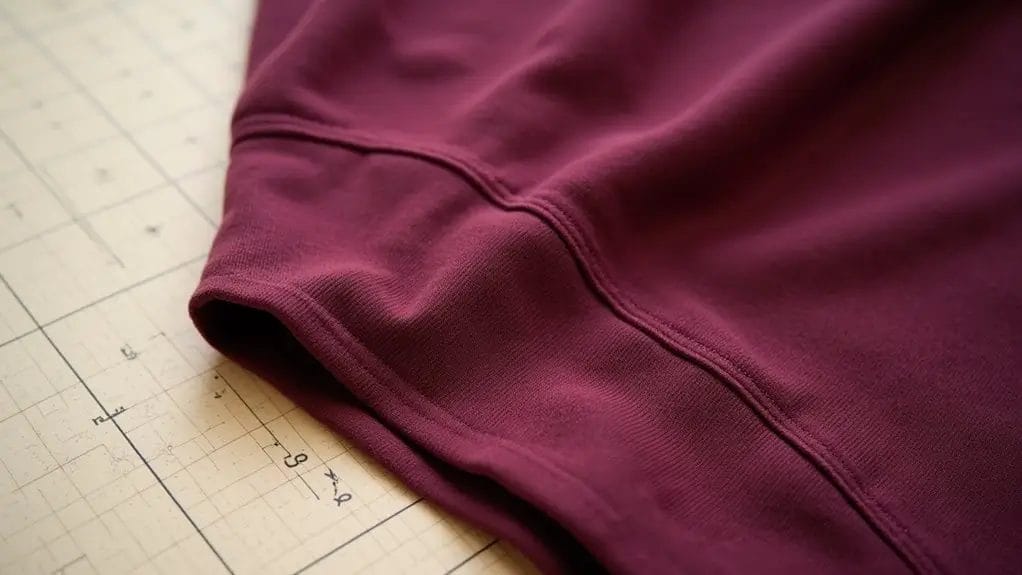
When hemming your ponte knit garments, you'll achieve the best results using a twin needle to create a professional-looking double line of stitching on the right side and a zigzag effect underneath.
You can strengthen waistbands and necklines by incorporating clear elastic or stay tape as stabilizers, which prevent stretching while maintaining the fabric's natural recovery.
For a clean finish on unlined garments, consider using a serger to create a rolled hem or applying a knit interfacing to areas that require additional structure.
Hemming Ponte Knit Fabric
Proper hemming techniques are essential for achieving a professional finish on your ponte knit garments. The medium weight of ponte fabric allows for versatile hemming options that create comfortable, polished edges.
- Use a twin needle to create parallel stitching lines that mimic professional coverstitch machines - this technique allows the hem to stretch without breaking.
- Press your hem thoroughly before stitching, following your pattern's recommended depth, typically 1-1.5 inches for ponte knits.
- Consider using a walking foot to prevent the layers from shifting while you sew, ensuring even feed of both fabric layers.
When hemming ponte, maintain consistent seam allowances and avoid stretching the fabric while stitching.
Adding Elastic or Stabilizers
Stabilizing ponte knit garments can elevate their professional appearance and enhance their durability. When adding elastic, select a width that's proportional to your garment's waistband or cuffs.
For ponte roma pieces requiring extra structure, incorporate clear elastic or stay tape at the shoulder seams and waistlines.
You'll find that stabilizers work particularly well in high-stress areas of your ponte garments. Apply fusible interfacing to necklines, armholes, and button plackets.
While ponte knit is more stable than regular jersey, strategic stabilization prevents unwanted stretching and maintains the fabric's shape through repeated wear and washing.
Troubleshooting Common Issues
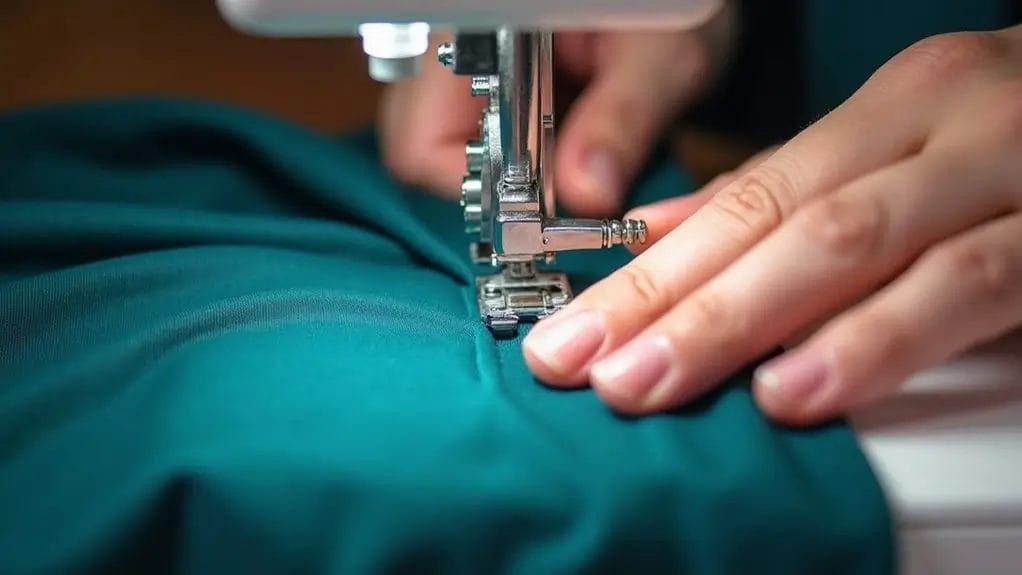
When sewing Ponte Roma, you'll need to address two key issues: stretching/skipping stitches and fabric bunching.
If your machine skips stitches, switch to a size 80 ballpoint needle and adjust your tension settings to prevent the fabric from stretching as you sew.
To fix fabric bunching, reduce your presser foot pressure and consider using a walking foot, which helps feed both layers of the double knit structure evenly through your machine.
Dealing with Stretching or Skipping Stitches
Stretching and skipping stitches can quickly derail your Ponte knit sewing project, but these issues are easily preventable with the right setup.
The stable nature of Ponte fabric makes it more forgiving than lighter knits, but proper technique remains essential for ideal coverage and professional results.
- Use a ballpoint needle size 80 to prevent the fabric from developing holes or snags while maintaining stitch integrity.
- Adjust your machine's tension to a slightly looser setting (around 3-4) to accommodate the fabric's natural stretch.
- Apply even pressure when guiding the fabric through your machine, avoiding pulling or stretching.
These adjustments will guarantee consistent stitches and maintain the Ponte knit's structure throughout your project.
Fixing Fabric Bunching
Fabric bunching can plague even experienced sewists working with Ponte knit, occurring most often at seam starts and around curved areas.
To prevent this issue, start by reducing your presser foot pressure to allow the fabric to feed smoothly without compression. When you notice bunching, stop sewing immediately and lift your presser foot to realign the layers.
For stubborn bunching, place tissue paper underneath your Ponte fabric while sewing. This stabilizes the knit and prevents stretching.
Test your stitch length on scraps first - a slightly longer stitch often minimizes bunching. Remember to handle your garment pieces with minimal stretching during construction.
Frequently Asked Questions
Can Ponte Roma Fabric Be Used for Swimwear or Activewear?
You shouldn't use Ponte Roma for swimwear or activewear. It's too heavy and lacks the necessary recovery and moisture-wicking properties. Instead, choose specialized performance fabrics like spandex, lycra, or athletic jersey blends.
How Long Does Ponte Roma Fabric Typically Last Before Pilling?
You'll typically see pilling on Ponte Roma fabric within 6-12 months of regular wear, though proper care can extend this. Higher-quality Ponte with spandex content and tighter knit structures resist pilling longer.
What's the Difference Between Ponte Roma and Scuba Fabric?
While both are double knits, you'll find Ponte Roma has a denser, more structured weave with visible ribs, whereas scuba fabric features a smoother, spongier texture and typically contains more synthetic fibers for a sleeker finish.
Does Ponte Roma Fabric Shrink Differently in Hot Versus Cold Water?
You'll experience more shrinkage in hot water with Ponte Roma fabric compared to cold washing. That's why it's crucial to pre-wash your fabric at the temperature you'll use for future garment care.
Can I Dye Ponte Roma Fabric at Home Successfully?
You'll have limited success dyeing Ponte Roma at home due to its synthetic fiber content. While natural fibers in the blend may take dye, polyester components won't absorb it, resulting in inconsistent coloring.
Conclusion
With proper tools and techniques, you'll achieve professional results when sewing ponte knit fabric. Remember to maintain correct needle size, stitch selection, and tension settings throughout your project. Pre-washing, pattern alignment, and careful handling prevent distortion and guarantee quality construction. When issues arise, adjust your machine settings and verify you're using appropriate stabilizers. Master these fundamentals, and you'll confidently create garments that showcase ponte knit's versatile properties. It's easy to love sewing with ponte, as its forgiving nature and beautiful drape make every project rewarding.


0 comments